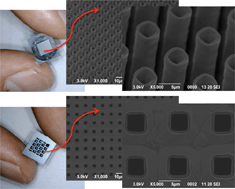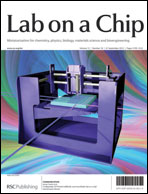The design, fabrication, and characterization of a minimally invasive silicon microchip for transdermal injection/sampling applications are reported and discussed. The microchip exploits an array of silicon-dioxide hollow microneedles with density of one million needles cm−2 and lateral size of a few micrometers, protruding from the front-side chip surface for one hundred micrometers, to inject/draw fluids into/from the skin. The microneedles are in connection with independent reservoirs grooved on the back-side of the chip. Insertion experiments of the microchip in skin-like polymers (agarose hydrogels with concentrations of 2% and 4% wt) demonstrate that the microneedles successfully withstand penetration without breaking, despite their high density and small size, according to theoretical predictions. Operation of the microchip with different liquids of biomedical interest (deionized water, NaCl solution, and D-glucose solution) at different differential pressures, in the range 10–100 kPa, highlights that the flow-rate through the microneedles is linearly dependent on the pressure-drop, despite the small section area (about 13 μm2) of the microneedle bore, and can be finely controlled from a few ml min−1 up to tens of ml min−1. Evaporation (at room temperature) and acceleration (up to 80 g) losses through the microneedles are also investigated to quantify the ability of the chip in storing liquids (drug to be delivered or collected fluid) in the reservoir, and result to be of the order of 70 nl min−1 and 1300 nl min−1, respectively, at atmospheric pressure and room temperature.

You have access to this article
 Please wait while we load your content...
Something went wrong. Try again?
Please wait while we load your content...
Something went wrong. Try again?


 Please wait while we load your content...
Please wait while we load your content...